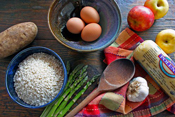2020-05-26 08:02:22

Need to cook gluten-free? Here's a set of basic guidelines
of what to eat, and what to avoid for those avoiding gluten.
Imagine if you were told you had to give up bread. And pasta. And cookies! Here’s a statistic for you.
Roughly three million people in the U.S. have to do just that. The reason?
Celiac disease. Celiac is an autoimmune disorder that is triggered by eating
gluten, the sticky elastic protein in wheat, rye, barley, and spelt that makes
pizza dough stretchy and bagels pleasantly chewy. The cure is a gluten-free
diet.
Learning to cook gluten-free is a challenge, but not an
insurmountable one. Armed with accurate information and a hefty dash of
patience, scratch cooks can adapt most recipes to gluten-free. Here are a few
beginner’s tips to get you started.
Keep it simple. Focus on whole, naturally gluten-free foods.
A good place to start? Fresh plain meat, poultry, and fish (check labels for
added broths, seasonings and marinades that may contain gluten). Whole eggs and
plain cheeses (again, read labels for added ingredients; whole milk products,
plain and block cheeses are generally safer than their low fat or fat free
cousins). Dairy based products such as milk, yogurt, sour cream and butter are
safe if additive-free. Vegetarians can enjoy legumes, nuts, seeds, and plain
tofu for protein. Vegetables and fruit are gluten-free. Potatoes are a
lifesaver (many a night I have based a meal around baked or mashed potatoes).
Gluten-free grain choices include rice and risotto, quinoa,
corn and polenta, millet and buckwheat. White and yellow corn tortillas make
Mexican recipes a family favorite in our gluten-free kitchen. Enchiladas, tacos
and fajitas are easily gluten-free. Brown rice tortilla wraps are fabulous for
burrito style sandwiches and even BLT’s. Gluten-free pasta made from brown rice
is excellent, as are traditional Asian rice noodles. Rice paper wraps (used to
make spring rolls) are usually gluten-free; wonton wraps are not.
Starches and thickeners for gluten-free cooking include
tapioca and tapioca starch, arrowroot, cornstarch and potato starch. Sweet rice
flour makes a smooth gravy.
Other foods to avoid include white flour, wheat berries and
bran, rye, barley, spelt, faro, couscous, pasta, malt and beer. Hidden gluten
is a troublemaker. Places gluten may lurk include soy sauce, gravy, broth,
marinades and sauces, spice mixtures and blends, roux and thickeners in soup,
malt vinegar and flavoring, seitan, mustard, salad dressings, tortillas and
wraps, breaded coatings, Japanese panko crumbs, cereal, granola, roasted nuts.
Commercial oats and oatmeal products are often contaminated (choose only
certified gluten-free oats).
When I first began my gluten-free diet eight years ago I
relied on back to basics scratch cooking to get me through. Planning simple
home cooked meals and choosing naturally gluten-free whole foods made my
transition into the gluten-free lifestyle much easier.
© 2024 XPAT LINK • ALL RIGHTS RESERVED